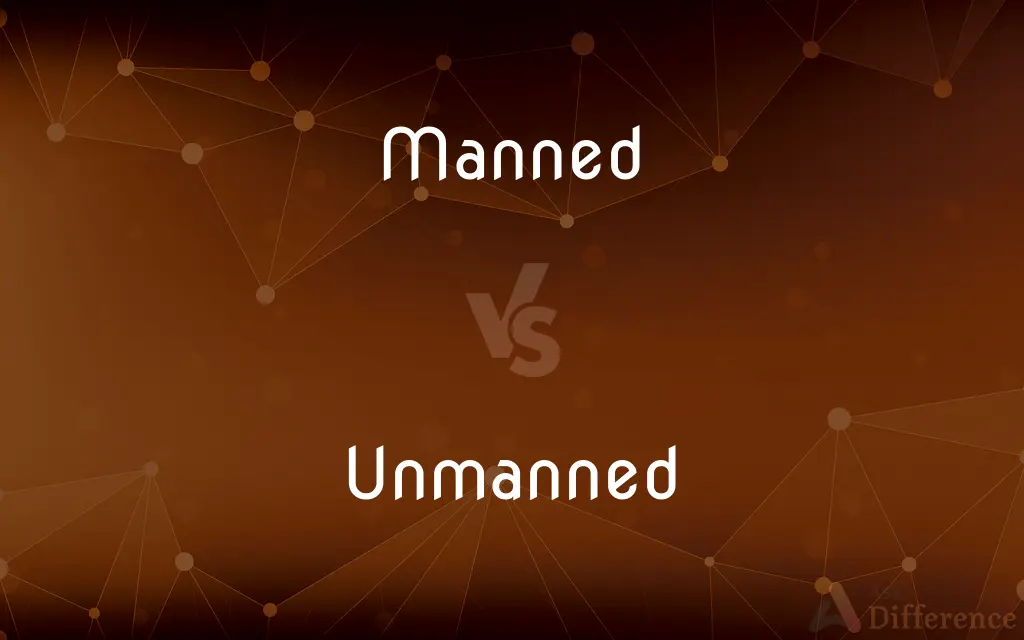Manned vs. Unmanned — What's the Difference?
By Maham Liaqat & Fiza Rafique — Updated on March 29, 2024
Manned refers to vehicles or missions involving human crew, while unmanned involves machines operating without people on board.

Difference Between Manned and Unmanned
Table of Contents
ADVERTISEMENT
Key Differences
Manned vehicles or missions involve the presence and direct participation of human beings. This human element is crucial for tasks requiring complex decision-making, adaptability, and intuition, especially in unpredictable environments. On the other hand, unmanned vehicles or systems operate without humans physically present, relying on autonomous systems, remote controls, or pre-programmed instructions. These are particularly useful in environments too dangerous, distant, or difficult for humans to endure.
In the context of space exploration, manned missions, such as those to the International Space Station (ISS), allow astronauts to conduct experiments, perform maintenance, and gather firsthand experience of space, which can be invaluable for scientific research and human endurance studies. Conversely, unmanned spacecraft, like the Mars rovers, are designed to explore environments where human survival is currently impossible, conducting ground-breaking research without risking human lives.
Manned military operations, involving soldiers on the ground or pilots in aircraft, enable immediate human judgment and adaptability in complex situations, potentially leading to more nuanced responses in conflict zones. Unmanned military systems, such as drones, are used for surveillance, reconnaissance, and even combat roles, minimizing the risk to human life and extending capabilities beyond human limitations.
Underwater exploration offers another perspective, with manned submarines and unmanned remotely operated vehicles (ROVs) serving different purposes. Manned submarines, carrying researchers, can make real-time decisions and adjustments based on direct observations. In contrast, unmanned ROVs can dive deeper and stay underwater longer, exploring areas beyond human reach without concerns for human safety.
In agriculture and industry, the distinction between manned and unmanned systems highlights the shift towards automation and efficiency. Manned machinery, like tractors and cranes, require operators, offering hands-on control and flexibility. Unmanned systems, including drones and autonomous tractors, are revolutionizing these fields by performing repetitive or precision tasks more efficiently and with less human labor.
ADVERTISEMENT
Comparison Chart
Presence
Human crew or operators onboard
No humans onboard; operates autonomously or remotely
Application
Space exploration, military, underwater exploration
Space exploration, military, surveillance, agriculture
Advantages
Human judgment, adaptability
Minimizes risk to human life, can operate in harsh environments
Limitations
Limited by human needs and safety
Limited by technology, no human intuition
Example
International Space Station (ISS)
Mars rovers, drones
Compare with Definitions
Manned
Direct human involvement.
Manned security patrols offer immediate response.
Unmanned
Often equipped with advanced technology.
Unmanned underwater vehicles use sonar to map the ocean floor.
Manned
Requiring a human operator or crew.
Manned missions to the moon highlighted human exploration capabilities.
Unmanned
Operating without a human crew.
Unmanned aerial vehicles (UAVs) are used for reconnaissance.
Manned
Subject to human endurance limits.
Manned flights are planned around the physical and psychological needs of the crew.
Unmanned
Can perform repetitive or hazardous tasks.
Unmanned drones are deployed for monitoring wildfires.
Manned
Equipped for human safety and needs.
Manned submarines explore the ocean with researchers onboard.
Unmanned
Autonomous or remotely controlled.
Unmanned spacecraft can land on celestial bodies without direct human intervention.
Manned
Involving human presence.
Manned spacecraft require life support systems.
Unmanned
Designed for tasks in inhospitable environments.
Unmanned rovers are ideal for exploring Mars.
Manned
Transporting, operated by, or performed by a human or humans
A manned spacecraft.
Several manned lunar landings.
Unmanned
Not crewed
An unmanned spacecraft.
Manned
Operated by, performed by, or transporting a person; crewed; piloted; staffed.
Unmanned
(Obsolete) Not trained. Used of a hawk.
Manned
Simple past tense and past participle of man
Unmanned
Not operated by a person or a crew.
An automated e-mail message sent from an unmanned mailbox
Manned
Having a crew; - of vehicles; as, a manned earth satellite was considered a necessary research step; to minimize casualties, the military used cruise missiles rather than manned aircraft for the bombardment. Opposite of unmanned.
Unmanned
Of a bird of prey: not accustomed to the presence of human beings.
Manned
Having a crew;
A manned earth satellite was considered a necessary research step
Unmanned
Simple past tense and past participle of unman
Unmanned
Deprived of manly qualities; deficient in vigor, strength, courage, etc.; weak; effeminate.
Unmanned
Not furnished with men; as, an unmanned ship.
Unmanned
Lacking a crew;
An unmanned satellite to Mars
Common Curiosities
Why are unmanned vehicles important in military operations?
Unmanned vehicles minimize the risk to human life and can operate in environments and situations too dangerous for humans.
How do advancements in AI impact unmanned systems?
Advancements in AI improve the autonomy, decision-making, and operational efficiency of unmanned systems, expanding their capabilities and applications.
What advancements are needed to enhance unmanned systems further?
Advancements in artificial intelligence, machine learning, battery technology, and materials science are crucial for enhancing autonomy, efficiency, durability, and the range of applications for unmanned systems.
How do environmental conditions affect manned and unmanned missions differently?
Manned missions require more stringent safety measures and life-support systems to protect humans in adverse conditions, while unmanned missions can often proceed in more extreme conditions with less risk but may face technical challenges like sensor malfunction or communication disruption.
What distinguishes a manned mission from an unmanned one?
A manned mission involves human presence and direct participation, while an unmanned mission operates without humans onboard, using autonomous systems or remote control.
How do manned and unmanned systems coexist in space exploration?
They complement each other; manned missions focus on human endurance and scientific research requiring human touch, while unmanned missions explore and study environments not yet accessible or safe for humans.
What are the challenges of operating unmanned vehicles?
Challenges include technological limitations, the need for sophisticated control systems, and ensuring reliable operation in unpredictable environments.
What are the ethical considerations for using unmanned systems?
Ethical considerations include ensuring responsible use, particularly in military applications to prevent unnecessary harm, and addressing privacy concerns in surveillance applications.
Can unmanned systems contribute to manned mission safety?
Yes, unmanned systems can perform reconnaissance, provide advanced warnings, and carry out hazardous tasks, thereby reducing risks and enhancing the safety of manned missions in various contexts, including space exploration, military operations, and disaster response.
Can unmanned systems replace manned ones entirely?
While unmanned systems offer many advantages, especially in risk reduction and efficiency, the intuition, judgment, and adaptability of humans are irreplaceable in many scenarios.
Are unmanned vehicles safer than manned ones?
Unmanned vehicles remove humans from dangerous environments, enhancing safety, but they rely heavily on technology, which can have its own vulnerabilities.
How has the use of unmanned vehicles changed agriculture?
Unmanned vehicles have revolutionized agriculture by performing tasks more efficiently, with precision, and reducing the need for manual labor.
What role do unmanned vehicles play in environmental research?
They play a crucial role by accessing remote or hazardous areas without human risk, collecting data that can inform climate change research, conservation efforts, and pollution monitoring.
How do manned and unmanned vehicles communicate in joint operations?
In joint operations, they communicate through integrated control systems, using satellite, radio, or internet-based communication technologies to coordinate tasks and share information.
Share Your Discovery

Previous Comparison
Viola vs. Viol
Next Comparison
Recognition vs. AcknowledgmentAuthor Spotlight
Written by
Maham LiaqatCo-written by
Fiza RafiqueFiza Rafique is a skilled content writer at AskDifference.com, where she meticulously refines and enhances written pieces. Drawing from her vast editorial expertise, Fiza ensures clarity, accuracy, and precision in every article. Passionate about language, she continually seeks to elevate the quality of content for readers worldwide.














































